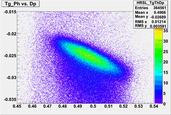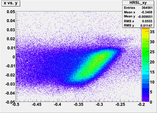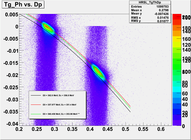My raw data: Datas2.xls (10/3/2008)
The analysis results (using the Nilangas fitting formula): Report6.pdf (10/3/2008)
The appendix to the Report6.pdf: Mail_for_Doug2.pdf (10/3/2008)
The collimator size problem :
 2.)
2.)  3.)
3.)  4.)
4.) 
A potential problem with the use of the Nilangas formula

Cuts on the scettering angle and direct Gaussian fits :




New results (HRSL):
a.) th = 24.0 deg : E0 = 360.482 MeV ........ Ec = 353.98 MeV
b.) th = 24.0 deg : E0 = 360.352 MeV ........ Ec = 353.98 MeV
c.) th = 28.3 deg : E0 = 360.347 MeV ........ Ec = 351.89 MeV
d.) th = 28.3 deg : E0 = 360.591 MeV ........ Ec = 351.89 MeV
e.) th = 32.5 deg : E0 = 360.543 MeV ........ Ec = 349.45 MeV
f.) th = 16.0 deg : E0 = 360.431 MeV ........ Ec = 353.98 MeV
10.) 11.)
11.) 
The mean beam energy (HRSL data only): E0 = ( 360.46 \pm 0.10 ) MeV
New results (HRSR):
g.) th = 28.3 deg : E0 = 360.610 MeV ........ Ec = 350.76 MeV
h.) th = 20.0 deg : E0 = 360.462 MeV ........ Ec = 350.76 MeV
i.) th = 14.0 deg : E0 = 360.446 MeV ........ Ec = 350.76 MeV
j.) th = 16.0 deg : E0 = 360.468 MeV ........ Ec = 350.76 MeV
12.) 13.)
13.) 
The mean beam energy (HRSR data only): E0 = ( 360.496 \pm 0.076 ) MeV
The Tiefenbach :

The mean Tiefenbach energy : E0 = ( 360.902 \pm 0.169 ) MeV